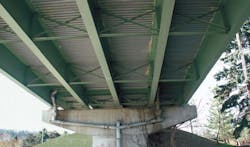No gap in performance
When the Windgap Bridge in western Pennsylvania was last painted in 1986, the Allegheny County Department of Public Works Bridge Division hoped their choice of an experimental paint system would deliver long-term performance. But they had no idea the new aliphatic polyester polyurethane coating system they selected would far exceed their greatest expectations. After more than two decades of use, the coating on the busy Windgap Bridge still looks great.
The coating system, manufactured by Tnemec, utilized the latest polyurethane resin technology developed by Bayer MaterialScience . Not only was it easy to apply, the new coating system exhibited a number of advantages that would eventually prove the coating system to be cost-effective.
Although the Department of Public Works originally specified a phenolic zinc-rich primer for the bridge, the manufacturer recommended a moisture-cured polyurethane zinc-rich primer instead. An intermediate coat of catalyzed epoxy was applied next, followed by a topcoat of a two-component aliphatic polyester polyurethane.
For more than 21 years, the Windgap Bridge has stood up to rugged use. Located just west of downtown Pittsburgh, the bridge has been subjected to plenty of traffic, tough weather conditions and emissions from industrial neighbors. Yet inspection report after inspection report proves the bridge coating remains in excellent condition.
According to Carl Angeloff, P.E., Head-BD Corrosion, NAFTA Business Development, Bayer MaterialScience , the coating system was inspected immediately after the initial application, then annually for the first five years of use. KTA-Tator, an independent inspection firm, examined 12 different locations across the underside of the bridge each time, and checked for coating thickness, adhesion and gloss. Minimal changes were noted throughout the five-year exposure period.
In April 2007, 16 years after the last inspection, KTA-Tator conducted another inspection and confi rmed that the coating system was still in excellent condition. Their report stated, “The overall rate of rusting and the coating breakdown (0.03% or less of the painted surface area) is considered to be low, especially for a structure that is subject to the Pennsylvania winter freeze/thaw cycling and the frequent application of corrosive deicing salts.” KTA-Tator’s report further noted that although leakage in the expansion joints of the concrete on the bridge deck caused minor corrosion to the adjoining painted steel, these were the only areas of corrosion on the bridge.
For the Allegheny County Department of Public Works, this reliable coating system bridges the gap between long-term performance and cost-effectiveness.
